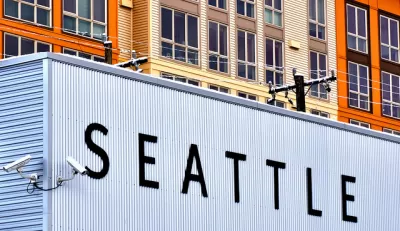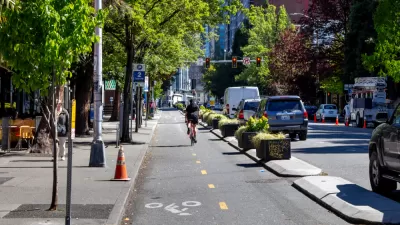Mayor Ed Murray released a 20-year growth plan, Seattle 2035, that retains LOS, but rather than measuring vehicle congestion, measures mode share, consistent with his vision for a green and sustainable city, but rattling The Seattle Times.

"Mayor Ed Murray today transmitted his proposal to update Seattle’s 20-year Comprehensive Plan to the Seattle City Council," states the mayor's May 3 press release. "Seattle 2035 [580-page PDF] focuses on equitable growth as Seattle expects gain 120,000 residents, 115,000 jobs, and 70,000 housing units over the next two decades."
Currently, level of service (LOS) is measured using the auto-centric volume/capacity (v/c) ratio, "but using it to measure system performance does not help achieve the Comprehensive Plan’s goal '…to safely and efficiently connect and move people and goods to their destinations',” states the 8-page section [PDF], "Proposed Change to Level of-Service Standards."
It is also inconsistent with the reality that Seattle has limited ability to increase the capacity of the street system, and it effectively means there are few practical remedies for a situation where the ratio is exceeded except through significant capital investment or changing the standard. [Hence, change the standard!]
New LOS standard
The City will measure LOS based on single occupant vehicle (SOV) mode share, as it focuses on increasing people-moving capacity by reducing travel that is occurring via the least space-efficient mode during the most congested period of the day.
By shifting travel from SOVs to more efficient modes operating on less-congested transportation networks, Seattle will allow more people to travel in the same amount of space...
The goal is not to reduce mobility, just to shift to modes more consistent with Seattle 2035. The policy change would need to be approved by the City Council.
Mode share also leverages the available and future capacity of the transit, bicycle, and pedestrian systems (which the City has the ability to expand and, in the case of bike and pedestrian networks, leverages substantial underutilized capacity).
Alas, the metric change has aroused at least one critic who sees the change as proof that Murray is "engaged in a war on cars," according to a column by Seattle Times editorial board writer Brier Dudley on the proposed LOS change. Do read his column as he concisely describes the proposed policy change, even if he is mistaken on what it amounts to.
Most of all, this shift gives the finger to those who drive cars, meaning nearly all residents and businesses.
And how does he suggest to deal with congested intersections? "If streets fail, cities can limit development until improvements are made."
Limiting developments in the name of mitigating traffic contributed to California's affordable housing crisis, which is why the state is now changing from LOS to the vehicle-miles traveled metric. Already, Seattle's housing prices are beginning to look a bit like San Francisco's. And those improvements he has in mind, even if the city could afford to do them, would be inconsistent with the plan to make the city more sustainable.
But leave it to Streetsblog's Angie Schmitt to explain why changing to a mode share LOS doesn't amount to a "war on cars."
Even before the release of Seattle 2035, the city was working to reduce single-occupant vehicle trips, as a post last August indicated. The draft plan "sets the goal of reducing solo driving for downtown work trips to 25 percent of mode share and reducing it to 10 percent of non-work trips by 2035," wrote Josh Cohen for Next City.
The mode split is already impressive. A February 2015 post indicated that "60% of commuters don’t drive at all [to downtown], instead opting for transit, walking, or cycling."
San Francisco approach
San Francisco Planning Commission adopted the vehicle miles traveled metric, notes a March post.
The commission voted to remove automobile delay as a significant impact on the environment and replace it with a vehicle miles traveled threshold for all California Environmental Quality Act, or CEQA, environmental determinations.
Hat tip to L.A. Metro Transportation Headlines.
FULL STORY: City’s vision for a carless Seattle doesn’t match reality

Planetizen Federal Action Tracker
A weekly monitor of how Trump’s orders and actions are impacting planners and planning in America.

Maui's Vacation Rental Debate Turns Ugly
Verbal attacks, misinformation campaigns and fistfights plague a high-stakes debate to convert thousands of vacation rentals into long-term housing.

San Francisco Suspends Traffic Calming Amidst Record Deaths
Citing “a challenging fiscal landscape,” the city will cease the program on the heels of 42 traffic deaths, including 24 pedestrians.

Amtrak Rolls Out New Orleans to Alabama “Mardi Gras” Train
The new service will operate morning and evening departures between Mobile and New Orleans.

The Subversive Car-Free Guide to Trump's Great American Road Trip
Car-free ways to access Chicagoland’s best tourist attractions.

San Antonio and Austin are Fusing Into one Massive Megaregion
The region spanning the two central Texas cities is growing fast, posing challenges for local infrastructure and water supplies.
Urban Design for Planners 1: Software Tools
This six-course series explores essential urban design concepts using open source software and equips planners with the tools they need to participate fully in the urban design process.
Planning for Universal Design
Learn the tools for implementing Universal Design in planning regulations.
Heyer Gruel & Associates PA
JM Goldson LLC
Custer County Colorado
City of Camden Redevelopment Agency
City of Astoria
Transportation Research & Education Center (TREC) at Portland State University
Jefferson Parish Government
Camden Redevelopment Agency
City of Claremont





























